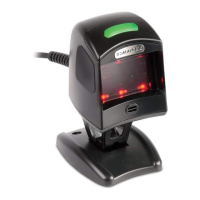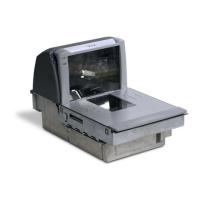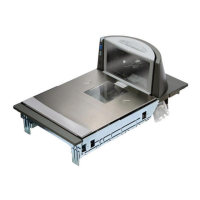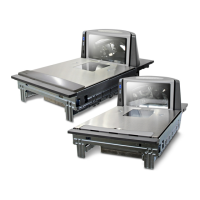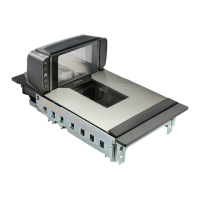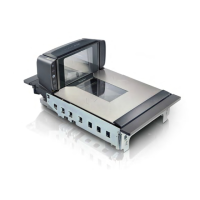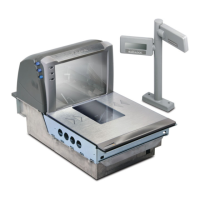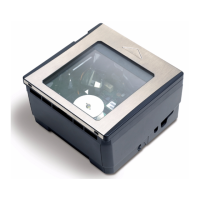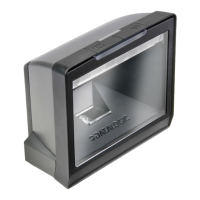Do you have a question about the Datalogic MAGELLAN 1000I and is the answer not in the manual?
Details manual contents, including connection, programming, and specifications.
Explains symbols used for key issues and procedures within the manual.
Instructions for connecting the scanner to terminals, PCs, and other host devices.
Guides on configuring scanner settings via programming barcodes and resetting defaults.
Describes general LED and beeper indications for scanner functions and errors.
Lists scanner error codes, their meanings, and recommended corrective actions.
Sets time limit for reading identical labels to prevent double reads.
Configures time after last label segment before preparing for a new label.
Appends label quality data for external computer analysis.
Sets inactivity time before the scanner enters sleep mode.
Configures specific LED/beeper alerts for scanner events like power-on and good reads.
Details advanced scanning modes like Targeted Scanning Mode and its timing parameters.
Lists supported interfaces (RS-232, IBM, USB, Keyboard Wedge) and their page references.
Details PC compatibility for various Keyboard Wedge interface types (A-Y).
Allows selection of the scanner's communication interface type via programming barcodes.
Configures scanner response to host commands.
Sets the number of buffered host transmissions to manage concurrent reads and transmissions.
Configures RS-232 parameters: Baud rate, data bits, parity, flow control, echo, and timing.
Manages data transmission flow using hardware signals like CTS.
Inserts delays between transmitted characters to ensure reliable data reception.
Enables/disables software flow control using XON/XOFF characters.
Configures host echo for daisy-chaining RS-232 devices.
Specifies RS-232 inactivity time before breaking the echo loop.
Sets TTL levels on RS-232 output pins TxD and RTS.
Enables/disables inversion of RS-232 TXD and RXD signals.
Configures scanner beeps for ASCII BEL character reception.
Selects whether the host beeps on a not-on-file condition.
Configures RS-232 ACK/NAK protocol for data transmission and command acknowledgment.
Sets specific ACK/NAK characters and configures timeout values.
Configures timeout values and retry counts for ACK/NAK responses.
Sets the number of times the scanner retries a label transmission.
Specifies how the scanner handles errors during ACK/NAK communication.
Enables/disables bad-label indication upon transmission failure.
Configures USB-OEM device as Table Top or Handheld scanner.
Covers IBM Transmit Labels in Code 39 Format and default settings.
Describes Wand Emulation, supported symbologies, and barcode format requirements.
Configures signal polarity for Wand Emulation.
Sets the output signal level for the wand when it is idle.
Adjusts transmission speed by setting the width of the minimum narrow bar.
Enables/disables noise pulses and converts symbologies in Wand Emulation.
Details scanner support for PCs/IBM terminals via Keyboard Wedge and USB Keyboard.
Supports country keyboard layouts for Keyboard Wedge and USB Keyboard.
Configures character transmission format regarding the Caps Lock state.
Simulates keyboard status during PC power-on for systems without a keyboard.
Defines how the scanner transmits ASCII control characters to the host.
Sets time to look for keyboard activity before breaking connection to transmit data.
Provides instructions for setting up the USB COM interface with Windows drivers.
Introduces building custom message strings by adding data elements to scanned barcodes.
Allows adding ASCII characters as prefixes or suffixes to barcode data globally.
Configures the transmission of Automatic Identification Manufacturers (AIM) label identifiers.
Allows configuring custom Label IDs per symbology or using industry-standard AIM ID.
Converts scanned barcode data to either upper or lower case.
Allows conversion of specific characters within scanned data based on hex values.
Configures UPC-A barcode reading options, including enable/disable and check digit.
Configures UPC-E barcode reading options, including enable/disable and check digit.
Configures translation of UPC/EAN labels to the 14-digit GTIN format.
Configures EAN-13 barcode reading options, including enable/disable and check digit.
Configures EAN-8 barcode reading options, including enable/disable and check digit.
Enables or disables the scanner's ability to decode EAN two-label pairs.
Configures reading of 2-digit, 5-digit, and Code 128 add-ons for UPC/EAN barcodes.
Configures options for GS1 DataBar Omnidirectional and Stacked symbologies.
Configures options for GS1 DataBar Expanded and Stacked symbologies.
Configures options for the GS1 DataBar Limited symbology.
Configures Code 39 barcode reading options, including check character settings.
Configures Pharmacode 39 barcode reading options, including start/stop characters.
Configures Code 128 and EAN 128 barcode reading options, including function characters.
Configures Interleaved 2 of 5 barcode reading options, including check digit calculation.
Configures Codabar barcode reading options, including check character verification.
Configures Code 93 barcode reading options.
Configures MSI/Plessey barcode reading options, including check digit verification.
Configures Standard 2 of 5 barcode reading options.
Configures PDF 417 barcode reading options, including length control.
Configures Datamatrix barcode reading options, including length control.
Details how to capture images using the scanner and their format.
Lists performance metrics like scan volume, rate, resolution, depth of field, and contrast ratio.
Provides physical dimensions of the scanner and its base station.
Details scanner and base station dimensions and weight.
Specifies operating voltage and input current for the scanner.
Lists operating/storage temperatures, light, humidity, and vibration specifications.
Mentions EAS support availability for the scanner.
Details pinouts for RS-232, IBM, USB, and Wand Emulation interface cables.
Details pinouts for USB-OEM, USB Keyboard, and USB COM interface cables.
Details pinouts for the Wand Emulation interface cable.
Details pinouts for the Keyboard Wedge interface cable.
Provides a visual reference of barcodes corresponding to alphanumeric characters for programming.
Lists default settings for key features across various barcode symbologies.
Details default setting exceptions for interfaces other than standard RS-232.
Lists default settings for IBM interfaces like USB-OEM, Port 9B, 5B, and 17.
Lists default setting exceptions for the RS-232 Wincor/Nixdorf interface.
Lists default settings for the Wand Emulation interface.
Lists default settings for USB Keyboard and Keyboard Wedge interfaces.
Summarizes keyboard models, protocols, scancode sets, and features.
Maps ASCII values to keys and scancodes for Scanset 1 keyboards.
Maps ASCII values to keys and scancodes for Scanset 2 keyboards.
Maps ASCII values to keys and scancodes for Scanset 3 (102-Key) keyboards.
Maps ASCII values to keys and scancodes for Scanset 3 (122-Key) keyboards.
Maps ASCII values to keys and scancodes for Japanese DOS keyboards.
Maps ASCII values to keys and scancodes for NEC 9801 keyboards.
Lists RS-232 commands the scanner responds to, including ASCII and HEX values.
Displays examples of various barcode symbologies supported by the scanner.
Details manual contents, including connection, programming, and specifications.
Explains symbols used for key issues and procedures within the manual.
Instructions for connecting the scanner to terminals, PCs, and other host devices.
Guides on configuring scanner settings via programming barcodes and resetting defaults.
Describes general LED and beeper indications for scanner functions and errors.
Lists scanner error codes, their meanings, and recommended corrective actions.
Sets time limit for reading identical labels to prevent double reads.
Configures time after last label segment before preparing for a new label.
Appends label quality data for external computer analysis.
Sets inactivity time before the scanner enters sleep mode.
Configures specific LED/beeper alerts for scanner events like power-on and good reads.
Details advanced scanning modes like Targeted Scanning Mode and its timing parameters.
Lists supported interfaces (RS-232, IBM, USB, Keyboard Wedge) and their page references.
Details PC compatibility for various Keyboard Wedge interface types (A-Y).
Allows selection of the scanner's communication interface type via programming barcodes.
Configures scanner response to host commands.
Sets the number of buffered host transmissions to manage concurrent reads and transmissions.
Configures RS-232 parameters: Baud rate, data bits, parity, flow control, echo, and timing.
Manages data transmission flow using hardware signals like CTS.
Inserts delays between transmitted characters to ensure reliable data reception.
Enables/disables software flow control using XON/XOFF characters.
Configures host echo for daisy-chaining RS-232 devices.
Specifies RS-232 inactivity time before breaking the echo loop.
Sets TTL levels on RS-232 output pins TxD and RTS.
Enables/disables inversion of RS-232 TXD and RXD signals.
Configures scanner beeps for ASCII BEL character reception.
Selects whether the host beeps on a not-on-file condition.
Configures RS-232 ACK/NAK protocol for data transmission and command acknowledgment.
Sets specific ACK/NAK characters and configures timeout values.
Configures timeout values and retry counts for ACK/NAK responses.
Sets the number of times the scanner retries a label transmission.
Specifies how the scanner handles errors during ACK/NAK communication.
Enables/disables bad-label indication upon transmission failure.
Configures USB-OEM device as Table Top or Handheld scanner.
Covers IBM Transmit Labels in Code 39 Format and default settings.
Describes Wand Emulation, supported symbologies, and barcode format requirements.
Configures signal polarity for Wand Emulation.
Sets the output signal level for the wand when it is idle.
Adjusts transmission speed by setting the width of the minimum narrow bar.
Enables/disables noise pulses and converts symbologies in Wand Emulation.
Details scanner support for PCs/IBM terminals via Keyboard Wedge and USB Keyboard.
Supports country keyboard layouts for Keyboard Wedge and USB Keyboard.
Configures character transmission format regarding the Caps Lock state.
Simulates keyboard status during PC power-on for systems without a keyboard.
Defines how the scanner transmits ASCII control characters to the host.
Sets time to look for keyboard activity before breaking connection to transmit data.
Provides instructions for setting up the USB COM interface with Windows drivers.
Introduces building custom message strings by adding data elements to scanned barcodes.
Allows adding ASCII characters as prefixes or suffixes to barcode data globally.
Configures the transmission of Automatic Identification Manufacturers (AIM) label identifiers.
Allows configuring custom Label IDs per symbology or using industry-standard AIM ID.
Converts scanned barcode data to either upper or lower case.
Allows conversion of specific characters within scanned data based on hex values.
Configures UPC-A barcode reading options, including enable/disable and check digit.
Configures UPC-E barcode reading options, including enable/disable and check digit.
Configures translation of UPC/EAN labels to the 14-digit GTIN format.
Configures EAN-13 barcode reading options, including enable/disable and check digit.
Configures EAN-8 barcode reading options, including enable/disable and check digit.
Enables or disables the scanner's ability to decode EAN two-label pairs.
Configures reading of 2-digit, 5-digit, and Code 128 add-ons for UPC/EAN barcodes.
Configures options for GS1 DataBar Omnidirectional and Stacked symbologies.
Configures options for GS1 DataBar Expanded and Stacked symbologies.
Configures options for the GS1 DataBar Limited symbology.
Configures Code 39 barcode reading options, including check character settings.
Configures Pharmacode 39 barcode reading options, including start/stop characters.
Configures Code 128 and EAN 128 barcode reading options, including function characters.
Configures Interleaved 2 of 5 barcode reading options, including check digit calculation.
Configures Codabar barcode reading options, including check character verification.
Configures Code 93 barcode reading options.
Configures MSI/Plessey barcode reading options, including check digit verification.
Configures Standard 2 of 5 barcode reading options.
Configures PDF 417 barcode reading options, including length control.
Configures Datamatrix barcode reading options, including length control.
Details how to capture images using the scanner and their format.
Lists performance metrics like scan volume, rate, resolution, depth of field, and contrast ratio.
Provides physical dimensions of the scanner and its base station.
Details scanner and base station dimensions and weight.
Specifies operating voltage and input current for the scanner.
Lists operating/storage temperatures, light, humidity, and vibration specifications.
Mentions EAS support availability for the scanner.
Details pinouts for RS-232, IBM, USB, and Wand Emulation interface cables.
Details pinouts for USB-OEM, USB Keyboard, and USB COM interface cables.
Details pinouts for the Wand Emulation interface cable.
Details pinouts for the Keyboard Wedge interface cable.
Provides a visual reference of barcodes corresponding to alphanumeric characters for programming.
Lists default settings for key features across various barcode symbologies.
Details default setting exceptions for interfaces other than standard RS-232.
Lists default settings for IBM interfaces like USB-OEM, Port 9B, 5B, and 17.
Lists default setting exceptions for the RS-232 Wincor/Nixdorf interface.
Lists default settings for the Wand Emulation interface.
Lists default settings for USB Keyboard and Keyboard Wedge interfaces.
Summarizes keyboard models, protocols, scancode sets, and features.
Maps ASCII values to keys and scancodes for Scanset 1 keyboards.
Maps ASCII values to keys and scancodes for Scanset 2 keyboards.
Maps ASCII values to keys and scancodes for Scanset 3 (102-Key) keyboards.
Maps ASCII values to keys and scancodes for Scanset 3 (122-Key) keyboards.
Maps ASCII values to keys and scancodes for Japanese DOS keyboards.
Maps ASCII values to keys and scancodes for NEC 9801 keyboards.
Lists RS-232 commands the scanner responds to, including ASCII and HEX values.
Displays examples of various barcode symbologies supported by the scanner.
| Tilt angle range | 0 - 360 ° |
|---|---|
| Decoding standards | 1D / Linear Codes: - Autodiscriminates all standard 1D codes including GS1 DataBar linear codes 2D Codes: - Data Matrix Stacked Codes: - GS1 DataBar Expanded Stacked - GS1 DataBar Stacked - GS1 DataBar Stacked Omnidirectional - PDF417 |
| Optical sensor resolution | 752 pixels |
| Standard interfaces | Keyboard wedge, USB, RS-232, RS-485 |
| Input voltage | 8.0 - 14.0 V |
| Power consumption | 400 mA |
| Dimensions (WxDxH) | 71 x 94 x 84 mm |
| Maximum operating distance | 0.171 m |
| Product color | Gray |
| Storage temperature (T-T) | -20 - 70 °C |
| Operating temperature (T-T) | 5 - 55 °C |
| Operating relative humidity (H-H) | 0 - 95 % |
| Weight | 198.5 g |
|---|
